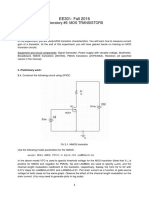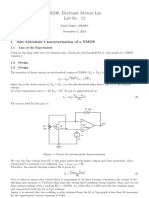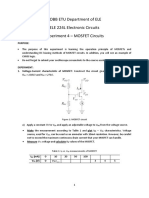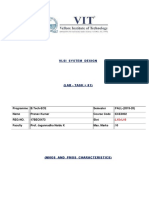0 ratings0% found this document useful (0 votes)
71 viewsCharacterizing The MOSFET With DC Voltage: Joshua S. Flores
This document summarizes an experiment characterizing an NMOS transistor using DC analysis. The experiment involved building a circuit with the transistor, resistors, and applying various voltages to the gate and drain. Measurements were then taken of the drain-source voltage, current, and gate-source voltage at each combination of applied voltages. Tables of results are presented along with calculations of expected values. While measured VDS and ID matched calculations well, measured VGS values did not match as expected, possibly due to issues with those measurements. The plot of the results showed the characteristic behavior of the transistor.
Uploaded by
agentradio24Copyright
© © All Rights Reserved
Available Formats
Download as DOCX, PDF, TXT or read online on Scribd
0 ratings0% found this document useful (0 votes)
71 viewsCharacterizing The MOSFET With DC Voltage: Joshua S. Flores
This document summarizes an experiment characterizing an NMOS transistor using DC analysis. The experiment involved building a circuit with the transistor, resistors, and applying various voltages to the gate and drain. Measurements were then taken of the drain-source voltage, current, and gate-source voltage at each combination of applied voltages. Tables of results are presented along with calculations of expected values. While measured VDS and ID matched calculations well, measured VGS values did not match as expected, possibly due to issues with those measurements. The plot of the results showed the characteristic behavior of the transistor.
Uploaded by
agentradio24Copyright
© © All Rights Reserved
Available Formats
Download as DOCX, PDF, TXT or read online on Scribd
You are on page 1/ 3
1
Abstract This lab serves to distinguish the trans-
characteristic of a given transistor using DC analysis for a
specified configuration.
I ndex Terms MOSFET, NMOS, V
DS
, V
GS
, V
DD
, I
D
, R
D
I. INTRODUCTION
HE type of transistor to be used in this experiment is the
MOSFET, or more specifically the metal-oxide-
semiconductor field-effect transistor, which is a three terminal
device and whose use varies depending on the desired
application. In our case, we will simply investigate the
behavior of the transistor by defining its trans-characteristic,
which will be accomplished by analyzing the circuit
configuration in the DC realm.
Our particular transistor will be utilized as an NMOS
transistor. By applying a positive voltage at the gate terminal
and having the source terminal grounded, a channel is induced
within the transistor which will allow for current to flow from
drain to source when a positive voltage is applied at the drain.
Several runs will be taken where certain voltages will be
applied at V
gg
and V
dd
to allow us to determine the trans-
characteristic of the transistor.
II. PROCEDURE
A. Building the configuration
The first thing placed in the printed circuit board was the
transistor itself. Then the configuration involved two resistors
connected in series. One having V
gg
applied directly to it while
the other was connected to a common ground. The values of
the resistors were in the order of magnitude of Mega Ohms.
The values chosen were 10M ohms. The purpose of having
extremely large values for the resistors is because they will act
as a choke during AC applications. Essentially they will guide
the current to the desired path.
The source terminal was connected to the common ground,
and the drain was connected to a resistor in the order of
magnitude of Kilo Ohms and measured in at 10K Ohms. This
resistor was connected directly to Vdd.
B. Measuring Vds ,Id and Vgs
The lab required to measure V
ds
,I
d
,and V
gs
as V
gg
and V
dd
varied. This would allow the plot of these values to display the
trans-characteristic of the transistor. I
d
could not be measured
directly due to the hazards surrounding that type of
measurement thus the voltage through the resistor had to be
measured instead which makes it possible to measure I
d
using
Ohms Law. Finally, V
gs
was measured just by measuring the
voltage from gate to source.
III. MATH
The Voltage drop between the drain and source of the
transistor is calculated by the voltage applied at the Drain
(VDD) and the drop across the resistor between them.
V
DS
= V
DD
- I
D
*R
D
VGS is then calculated via the voltage input of VGG and the
ratio between the resistance values in the circuit.
V
GS
= V
GG
* R
G2
/ (R
G1
/R
G2
)
This formula is simply the voltage division of the two resistors
in series.
R
G1
=10.12 M (measured)
R
G2
=9.81Mmeasured)
IV. FIGURES AND TABLES
In these tables V
gg
will be the columns and V
dd
will be the
rows.
Characterizing the MOSFET with DC Voltage
Joshua S. Flores
T
Voltage
through Rd[V]
Vgg/Vdd 0 1 2 3 4 5
0 0 0 0 0 0 0
2 1.43 1.44 1.55 1.79 1.99 2
4 3.41 3.42 3.53 3.75 3.98 4
6 5.4 5.41 5.5 5.72 5.97 6
8 7.39 7.4 7.49 7.7 7.96 8
10 9.39 9.39 9.48 9.69 9.95 10
2
Vds
Calc.[V]
Vgg/Vdd 1 2 3 4 5
0 0 0 0 0 0 0
2 0.57 0.56 0.45 0.21 0.01 0
4 0.59 0.58 0.47 0.25 0.02 0
6 0.6 0.59 0.5 0.28 0.03 0
8 0.61 0.6 0.51 0.3 0.04 0
10 0.61 0.61 0.52 0.31 0.05 0
Vds
measured[V]
Vgg/Vdd 0 1 2 3 4 5
0 0 0 0 0 0 0
2 0.56 0.55 0.44 0.21 0.01 0.001
4 0.58 0.57 0.47 0.26 0.02 0.003
6 0.6 0.59 0.49 0.27 0.033 0.005
8 0.61 0.6 0.51 0.29 0.43 0.006
10 0.61 0.6 0.52 0.31 0.53 0.008
Current of Id[mA]
Vgg/Vdd 0 1 2 3 4 5
0 0 0 0 0 0 0
2 0.0563 0.0553 0.0445 0.0208 0.00099 0
4 0.0583 0.0573 0.0464 0.0247 0.00198 0
6 0.0593 0.0583 0.0494 0.0277 0.00296 0
8 0.0603 0.0593 0.0504 0.0296 0.00395 0
10 0.0603 0.0603 0.0514 0.0306 0.00494 0
Vgs Measured[V]
Vgg Vgs
0 0
1 0.323
2 0.646
3 0.969
4 1.292
5 1.612
Vgs Calculated[V]
Vdd Vgs
0 0
1 0.488303
2 0.976605
3 1.464908
4 1.953211
5 2.441513
3
V. CONCLUSION
The lab produced values that were negligibly different from
those measured during the lab when measuring V
ds
and Id.
However, due to some unknown reason during the
measurements, the values of V
gs
were completely off when
comparing those values to the theoretical values. Even when
measuring the voltage drop between two different resistors in
series, the same reading of 0.54V was always read which was
very bizarre to say the least. Although, when analyzing the plot
it can be seen that our plotted values are in the same range as
our calculated values. For instance, at plot line created for 5V
at V
gg,
V
gs
is approximately 2.27 V which is still 6 percent off,
but better than the 34 percent using the measured values.
REFERENCES
[1] G. O. Young, Synthetic structure of industrial plastics (Book style with
paper title and editor), in Plastics, 2nd ed. vol. 3, J. Peters, Ed. New
York: McGraw-Hill, 1964, pp. 1564.
You might also like
- Laboratory Report JFET Transistor Characteristics40% (5)Laboratory Report JFET Transistor Characteristics5 pages
- EE301-Fall 2016: Laboratory #6: MOS TRANSISTORSNo ratings yetEE301-Fall 2016: Laboratory #6: MOS TRANSISTORS3 pages
- Lab 10: IV Characteristics of Mosfets CE 3110.104 Josh Hautt Lab Partner: Jonah Willis Lab Performed: 12/3/15 Lab Due: 12/10/15No ratings yetLab 10: IV Characteristics of Mosfets CE 3110.104 Josh Hautt Lab Partner: Jonah Willis Lab Performed: 12/3/15 Lab Due: 12/10/157 pages
- Electronics I - Laboratory 7 Field Effect Transistors 3. SE: EquipmentNo ratings yetElectronics I - Laboratory 7 Field Effect Transistors 3. SE: Equipment6 pages
- Pablo Vasquez Pocasangre MOSFET Electronics FINALNo ratings yetPablo Vasquez Pocasangre MOSFET Electronics FINAL19 pages
- L #5: Mosfet C A: Sfsu - E 301 - E L AB Haracteristics and PplicationsNo ratings yetL #5: Mosfet C A: Sfsu - E 301 - E L AB Haracteristics and Pplications14 pages
- TOBB ETU Department of ELE ELE 224L Electronic Circuits Experiment 4 - MOSFET CircuitsNo ratings yetTOBB ETU Department of ELE ELE 224L Electronic Circuits Experiment 4 - MOSFET Circuits5 pages
- ECE 321 Experiment 7 NMOS and PMOS Transistor CircuitsNo ratings yetECE 321 Experiment 7 NMOS and PMOS Transistor Circuits11 pages
- Mos Field-Effect Transistors (Mosfets) : Section 5.1: Device Structure and Physical Operation100% (1)Mos Field-Effect Transistors (Mosfets) : Section 5.1: Device Structure and Physical Operation16 pages
- ETI063 - Analogue IC Design Laboratory ManualNo ratings yetETI063 - Analogue IC Design Laboratory Manual35 pages
- STEM: Science, Technology, Engineering and Maths Principles Teachers Pack V10From EverandSTEM: Science, Technology, Engineering and Maths Principles Teachers Pack V10No ratings yet
- Design of Electrical Circuits using Engineering Software ToolsFrom EverandDesign of Electrical Circuits using Engineering Software ToolsNo ratings yet
- 10 KV, 120 A SiC Half H-Bridge Power MOSFET Modules Suitable For High Frequency, Medium Voltage ApplicationsNo ratings yet10 KV, 120 A SiC Half H-Bridge Power MOSFET Modules Suitable For High Frequency, Medium Voltage Applications4 pages
- Full Download Handbook of Thin Film Deposition Techniques Principles Methods Equipment and Applications Second Editon 1st Edition Krishna Seshan (Author) PDF DOCX100% (8)Full Download Handbook of Thin Film Deposition Techniques Principles Methods Equipment and Applications Second Editon 1st Edition Krishna Seshan (Author) PDF DOCX67 pages
- Power Amplifier Owner'S Manual: UPDATED 2007-02-14No ratings yetPower Amplifier Owner'S Manual: UPDATED 2007-02-144 pages
- Arizona-Sonora Design For Manufacturing - Adan OrtizNo ratings yetArizona-Sonora Design For Manufacturing - Adan Ortiz6 pages
- MOSFET Non Ideal Effects: Prof. Jagannadha Naidu KNo ratings yetMOSFET Non Ideal Effects: Prof. Jagannadha Naidu K31 pages
- IEEE Journal Submission Trans On MTT ExampleNo ratings yetIEEE Journal Submission Trans On MTT Example10 pages

























































































